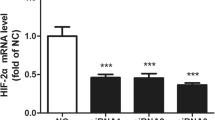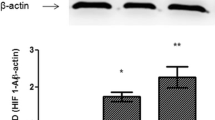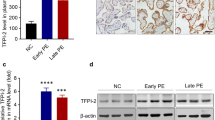Abstract
Background
Preeclampsia, a maternal hypertensive disease, is characterized by shallow invasion of the maternal spiral arterioles resulting in hypoxia/reperfusion type insult; however, the molecular mechanism is unknown. The aim of this study was to determine the mechanism of altered oxygen tension or inhibition of phosphatidyl-inositol-3-kinase (PI3K) on trophoblast survival and to investigate the effect of epidermal growth factor (EGF) on maintaining cellular integrity.
Materials and Method
We have used flow cytometry, immunoblotting, and fluoroimmunocytochemistry to study apoptosis in a characterized, spontaneously transformed first trimester extravillous-like trophoblast cell line that exhibits many characteristics of in vivo trophoblast.
Results
Time-dependent exposure of first trimester extra-villous-like trophoblast to all oxygen tensions tested promoted dissipation of the mitochondrial membrane potential (ψm) and resulted in a significant increase in cell death by 48 hr as determined by dual staining flow cytometry. Western blot analysis revealed expression of cleaved caspase-3 and caspase-9 increased with time with hypoxia and hyperoxia promoting the greatest elevation indicating that longer duration of exposure to a change in oxygen tension causes increased apoptosis via a mitochondrial-mediated pathway. Disruption of the anti-apoptotic PI3K pathway by LY294002 (40 µM), its specific inhibitor, caused further significant dissipation of the ψm (p < 0.01) and cleavage of caspase-3. EGF was able to maintain the ψm and to prevent cleavage of caspase-3 even in the presence of LY294002, indicating that its survival effects were independent of the PI3K pathway.
Conclusions
These results suggest that inhibition of the PI3K/Akt pathway can sensitize first-trimester trophoblastlike cells into oxygen-induced cell death and that EGF exerts its anti-apoptotic effect independently of PI3K/Akt.



Similar content being viewed by others
References
Damsky CH, Fitzgerald ML, Fisher SJ. (1992) Distribution patterns of extracellular matrix components and adhesion receptors are intricately modulated during first trimester cytotrophoblast differentiation along the invasive pathway, in vivo. J. Clin. Invest. 89: 210–222.
Cross JC, Werb Z, Fisher SJ. (1994) Implantation and the placenta: key pieces of the development puzzle. Science 266: 1508–1518.
Aplin JD: (1991) Implantation, trophoblast differentiation and haemochorial placentation: mechanistic evidence in vivo and in vitro. J. Cell Sci. 1991. 99: 681–692.
Levine RJ, Hauth JC, Curet LB, et al. (1997) Trial of calcium to prevent preeclampsia. N. Engl. J. Med. 337: 69–76.
Zhou Y, Damsky CH, Chiu K, et al. (1993) Preeclampsia is associated with abnormal expression of adhesion molecules by invasive cytotrophoblasts. J. Clin. Invest. 91: 950–960.
Caniggia I, Grisaru-Gravnosky S, Kuliszewsky M, et al. (1999) Inhibition of TGF-beta 3 restores the invasive capability of extravillous trophoblasts in preeclamptic pregnancies. J. Clin. Invest. 103: 1641–1650.
Benirschke K, Kaufmann P: Pathology of the Human Placenta, 3rd ed. Springer-Verlag, New York; 1995.
Khaliq A, Dunk C, Jiang J, et al. (1999) Hypoxia down-regulates placenta growth factor, whereas fetal growth restriction up-regulates placenta growth factor expression: molecular evidence for “placental hyperoxia” in intrauterine growth restriction. Lab. Invest. 79: 151–170.
Rodesch F, Simon P, Donner C, Jauniaux E. (1992) Oxygen measurements in endometrial and trophoblastic tissues during early pregnancy. Obstet. Gynecol. 80: 283–285.
Espinoza J, Sebire NJ, McAuliffe F, et al. (2001) Placental villus morphology in relation to maternal hypoxia at high altitude. Placenta 22: 606–608.
Levy R, Smith SD, Chandler K, et al. (2000) Apoptosis in human cultured trophoblasts is enhanced by hypoxia and diminished by epidermal growth factor. Am. J. Physiol. Cell Physiol. 278: C982–C988.
Kerr JF, Wyllie AH, Currie AR. (1972) Apoptosis: a basic biological phenomenon with wide-ranging implications in tissue kinetics. Br. J. Cancer 26: 239–257.
Messmer UK, Pfeilschifter J. (2000) New insights into the mechanism for clearance of apoptotic cells. Bioessays 22: 878–881.
Schneider P, Tschopp J. (2000) Apoptosis induced by death receptors. Pharm. Acta Helv. 74: 281–286.
Zimmermann KC, Bonzon C, Green DR. (2001) The machinery of programmed cell death. Pharmacol. Ther. 92: 57–70.
Thornberry NA, Lazebnik Y. (1998) Caspases: enemies within. Science 281: 1312–1316.
Rosfjord EC, Dickson RB. (1999) Growth factors, apoptosis, and survival of mammary epithelial cells. J. Mammary Gland Biol. Neoplasia 4: 229–237.
Liu W, Ahmad SA, Reinmuth N, et al. (2000) Endothelial cell survival and apoptosis in the tumor vasculature. Apoptosis 5: 323–328.
Kamata H, Tanaka C, Yagisawa H, Hirata H. (1996) Nerve growth factor and forskolin prevent H2O2-induced apoptosis in PC12 cells by glutathione independent mechanism. Neurosci. Lett. 212: 179–182.
Bass KE, Morrish D, Roth I, et al. (1994) Human cytotrophoblast invasion is up-regulated by epidermal growth factor: evidence that paracrine factors modify this process. Dev. Biol. 164: 550–561.
Zubilewicz A, Hecquet C, Jeanny J, et al. (2001) Proliferation of CECs requires dual signaling through both MAPK/ERK and PI 3-K/Akt pathways. Invest. Ophthalmol. Vis. Sci. 42: 488–496.
Xie H, Pallero MA, Gupta K, et al. (1998) EGF receptor regulation of cell motility: EGF induces disassembly of focal adhesions independently of the motility-associated PLCgamma signaling pathway. J. Cell Sci. 111: 615–624.
Roberts RA, James NH, Cosulich SC. (2000) The role of protein kinase B and mitogen-activated protein kinase in epidermal growth factor and tumor necrosis factor alphamediated rat hepatocyte survival and apoptosis. Hepatology 31: 420–427.
Varner MW, Dildy GA, Hunter C, et al. (1996) Amniotic fluid epidermal growth factor levels in normal and abnormal pregnancies. J. Soc. Gynecol. Investig. 3: 17–19.
Lindqvist P, Grennert L, Marsal K. (1999) Epidermal growth factor in maternal urine—a predictor of intrauterine growth restriction? Early Hum. Dev. 56: 143–150.
Faxen M, Nasiell J, Blanck A, et al. (1998) Altered mRNA expression pattern of placental epidermal growth factor receptor (EGFR) in pregnancies complicated by preeclampsia and/or intrauterine growth retardation. Am. J. Perinatol. 15: 9–13.
Diss EM, Gabbe SG, Moore JW, Kniss DA. (1992) Study of thromboxane and prostacyclin metabolism in an in vitro model of first-trimester human trophoblast. Am. J. Obstet. Gynecol. 167: 1046–1052.
Dunk C, Shams M, Nijjar S, et al. (2000) Angiopoietin-1 and angiopoietin-2 activate trophoblast Tie-2 to promote growth and migration during placental development. Am. J. Pathol. 156: 2185–2199.
Morgan M, Kniss D, McDonnell S. (1998) Expression of metalloproteinases and their inhibitors in human trophoblast continuous cell lines. Exp. Cell Res. 242: 18–26.
Khaliq A, Li XF, Shams M, et al. (1996) Localisation of placenta growth factor (PIGF) in human term placenta. Growth Factors 13: 243–250.
Bahn RS, Worsham A, Speeg KV, et al. (1981) Characterization of steroid production in cultured human choriocarcinoma cells. J. Clin. Endocrinol. Metab. 52: 447–450.
Hunt JS, Andrews GK, Wood GW. (1987) Normal trophoblasts resist induction of class I HLA. J. Immunol. 138: 2481–2487.
McMaster MT, Librach CL, Zhou Y, et al. (1995) Human placental HLA-G expression is restricted to differentiated cytotrophoblasts. J. Immunol. 154: 3771–3778.
Potgens AJ, Bolte M, Huppertz B, et al. (2001) Human trophoblast contains an intracellular protein reactive with an antibody against CD133—a novel marker for trophoblast. Placenta 22: 639–645.
Blaschitz A, Weiss U, Dohr G, Desoye G. (2000) Antibody reaction patterns in first trimester placenta: implications for trophoblast isolation and purity screening. Placenta 21: 733–741.
Shi Y. (2002) Mechanisms of caspase activation and inhibition during apoptosis. Mol. Cell. 9: 459–470.
Muschel RJ, Bernhard EJ, Garza L, et al. (1995) Induction of apoptosis at different oxygen tensions: evidence that oxygen radicals do not mediate apoptotic signaling. Cancer Res. 55: 995–998.
Graeber TG, Osmanian C, Jacks T, et al. (1996) Hypoxiamediated selection of cells with diminished apoptotic potential in solid tumours. Nature 379: 88–91.
Banasiak KJ, Haddad GG. (1998) Hypoxia-induced apoptosis: effect of hypoxic severity and role of p53 in neuronal cell death. Brain Res. 797: 295–304.
Carson JP, Kulik G, Weber MJ. (1999) Antiapoptotic signaling in LNCaP prostate cancer cells: a survival signaling pathway independent of phosphatidylinositol 3′-kinase and Akt/protein kinase B. Cancer Res. 59: 1449–1453.
Hirasawa N, Sato Y, Fujita Y, Mue S, Ohuchi K. (1998) Inhibition by dexamethasone of antigen-induced c-Jun N-terminal kinase activation in rat basophilic leukemia cells. J. Immunol. 161: 4939–4943.
Rameh LE, Rhee SG, Spokes K, et al. (1998) Phosphoinositide 3-kinase regulates phospholipase Cgamma-mediated calcium signaling. J. Biol. Chem. 273: 23750–23757.
Downing GJ, Kim S, Nakanishi S, et al. (1996) Characterization of a soluble adrenal phosphatidylinositol 4-kinase reveals wortmannin sensitivity of type III phosphatidylinositol kinases. Biochemistry 35: 3587–3594.
Ahmed A, Kilby MD. (1997) Hypoxia or hyperoxia in placental insufficiency? Lancet 350: 826–827.
Caniggia I, Winter J, Lye SJ, Post M. (2000) Oxygen and placental development during the first trimester: implications for the pathophysiology of pre-eclampsia. Placenta 21(Suppl A): S25–S30.
Maruo T, Matsuo H, Otani T, Mochizuki M. (1995) Role of epidermal growth factor (EGF) and its receptor in the development of the human placenta. Reprod. Fertil. Dev. 7: 1465–1470.
Amemiya K, Kurachi H, Adachi H, et al. (1994) Involvement of epidermal growth factor (EGF)/EGF receptor autocrine and paracrine mechanism in human trophoblast cells: functional differentiation in vitro. J. Endocrinol. 143: 291–301.
Acknowledgments
We are grateful to Dr D.A. Kniss (Ohio State University, Columbus, Ohio, USA) for the generous gift of spontaneously transformed trophoblast cell lines. Thanks also go to Dr O. Genbacev (California, USA) for provision of the anti-HLA-G antibody for characterization studies. We greatly appreciate the assistance with immunofluorescence (Dr B. Bussolati, Turin, Italy) and flow cytometry (Dr M Rahman, Birmingham, UK, and Mr. R. Bird, IDRL Birmingham, UK).
This work was funded by the British Heart Foundation Grant Numbers FS/1998079 and RG/98/0003.
Author information
Authors and Affiliations
Corresponding author
Rights and permissions
About this article
Cite this article
Perkins, J., St. John, J. & Ahmed, A. Modulation of Trophoblast Cell Death by Oxygen and EGF. Mol Med 8, 847–856 (2002). https://doi.org/10.1007/BF03402090
Accepted:
Published:
Issue Date:
DOI: https://doi.org/10.1007/BF03402090




